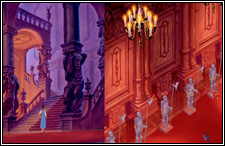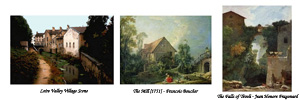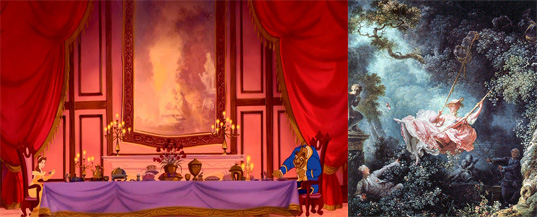Art History In Beauty and the Beast
I really love art, some of my favorite artists being Vincent van Gogh and Auguste Renoir. It is very widely known that the artists who were making Beauty and the Beast got their inspiration from French landscape and from artists, and that many of the castle paintings are real paintings. While watching Beauty and the Beast, I noticed many of these paintings and would pause to get a closer view. The paintings were even clearer when I was sorting the screen captures I took. I am very glad I took so many screen captures, for now I can go through them and post all of the art works on this page. This page is here to discuss the interesting art works and scenery presented in Beauty and the Beast. Some of this trivia is from the Trivia page, but I have moved it here because it deals with art works. I plan to go through each of my screen captures and try to match the art works on the Castle walls with real art works; hopefully I will find some; I have already recognized some I believe, and I will add them here shortly.Baroque and Rococo
 Cogworth describes part of the castle to Belle and says, "As you can see, the pseudo facade was stripped away to reveal a minimalist rococo design. Note the unusual inverted vaulted ceilings. This is yet another example of the neo-classic baroque period, and as I always say, if it's not baroque, don't fix it!"
Cogworth describes part of the castle to Belle and says, "As you can see, the pseudo facade was stripped away to reveal a minimalist rococo design. Note the unusual inverted vaulted ceilings. This is yet another example of the neo-classic baroque period, and as I always say, if it's not baroque, don't fix it!"
In the arts, Baroque (or baroque) is both a period and the artistic style that dominated it. The Baroque style used exaggerated motion and clear, easily interpreted detail to produce drama, tension, exuberance, and grandeur in sculpture, painting, literature, and music. The style started around 1600 in Rome, Italy and spread to most of Europe. In music, the Baroque applies to the final period of dominance of imitative counterpoint.
(The name adapted a French adjective that is derived from the Portuguese noun "barroco"; both described a pearl of irregular shape. Some confusion can occur in using for the period and style the lower-cased version "baroque", which can instead mean merely "elaborate" [or especially "overly elaborate"] without implying connection to the period.)
Cogsworth also mentions "rococo design", which emerged in France in the early 18th century as a continuation of the Baroque style, but in contrast to the heavier themes and darker colors of the Baroque, the Rococo was characterized by an opulence, grace, playfulness, and lightness.
Here is an example of a Neo Baroque (Left) and a Rococo design (Right), as well as the castle stairs and where Cogsworth was walking while describing the castle (underneath the two). The Neo-Baroque design of the foyer of Charles Garnier's Opira [left] reminds me of the stairway in the castle of Beauty and the Beast.


Inspiration of Art
 Art directors working on the film traveled to the Loire valley in France for inspiration. [A bit of Art and Fairytale history: The Loire Valley is also the valley in which the castle that inspired Charles Perrault to write Sleeping Beauty is located. Charles Perrault has also written a version of Beauty and the Beast.]
Art directors working on the film traveled to the Loire valley in France for inspiration. [A bit of Art and Fairytale history: The Loire Valley is also the valley in which the castle that inspired Charles Perrault to write Sleeping Beauty is located. Charles Perrault has also written a version of Beauty and the Beast.]
The style of illustration was inspired by French painters Fragonard and Boucher.
[The Mill, by Francois Boucher, reminds me somewhat of Belle's home with the water wheel at the side of the home.]

Castle Paintings
 Many of paintings on the walls of the castle are undetailed versions of famous paintings by such artists as Vermeer, Rembrandt, and Goya.
Many of paintings on the walls of the castle are undetailed versions of famous paintings by such artists as Vermeer, Rembrandt, and Goya. [I highly recommend Art.Com for beautiful paintings of every artist. I have been a fan of many artists for quite some time, and I also highly recommend Vincent van Gogh as well as Auguste Renoir. One of my favorite portraits is French, Le Bal a Bougival, by Renoir.]

 The movie uses 1,295 painted backgrounds and 120,000 drawings.
The movie uses 1,295 painted backgrounds and 120,000 drawings.

 In the scene where Beast is knocking on Belle's bedroom door to get her to come down to dinner (An Invitation to Dinner), after he rushes away, you can see the painting Girl with a Pearl Earring by Johannes Vermeer on the wall.
In the scene where Beast is knocking on Belle's bedroom door to get her to come down to dinner (An Invitation to Dinner), after he rushes away, you can see the painting Girl with a Pearl Earring by Johannes Vermeer on the wall.

 Right before the ballroom scene, Belle and Beast are having dinner and there is a large tapestry decorating the wall. This is apparently a painting of The Swing by Jean Fragonard. If you look closely, you can see that the painting in the movie is actually flipped, and that the statue is on the other side. Jean Fragonard was a French painter who helped inspire the imagery in the movie.
Right before the ballroom scene, Belle and Beast are having dinner and there is a large tapestry decorating the wall. This is apparently a painting of The Swing by Jean Fragonard. If you look closely, you can see that the painting in the movie is actually flipped, and that the statue is on the other side. Jean Fragonard was a French painter who helped inspire the imagery in the movie.

There is also a limited edition giclee on disneyshopping.com entitled "Tale As Old As Time" that has the dining scene with The Swing as the picture in the background.

